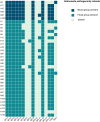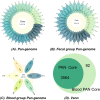AI-2 Signaling: A Potential Driver of Bacteremia in Non-Typhoidal Salmonella Infections
- PMID: 40123710
- PMCID: PMC11930269
- DOI: 10.2147/IDR.S507908
AI-2 Signaling: A Potential Driver of Bacteremia in Non-Typhoidal Salmonella Infections
Abstract
Introduction: Non-typhoidal Salmonella (NTS) infections typically present as localized inflammation near the intestinal mucosal epithelium. However, some NTS strains can breach the intestinal barrier and enter the bloodstream, leading to bacteremia and severe systemic infections. The mechanisms by which NTS invades the bloodstream remain unclear.
Methods: In this study, we isolated 36 NTS strains from patients with diarrhea and bacteremia at First Affiliated Hospital of Huzhou University. Strains represented two distinct clinical manifestations, and were subjected to whole-genome sequencing, comparative genomics, and genetic differentiation analysis to identify genes potentially involved in bloodstream invasion. Additionally, we conducted inhibition assays using quercetin, a chemical inhibitor of the identified gene pathways, to validate our findings.
Results: Our analysis revealed that genes distinguishing the bloodstream Salmonella isolates from the fecal Salmonella isolates were primarily involved in the AI-2 quorum sensing pathway and biofilm-associated protein transport. Subsequent biofilm formation assays demonstrated that the bloodstream isolates exhibited significantly higher biofilm formation capacity compared to the fecal isolates. Upon the addition of quercetin, biofilm formation was equally inhibited in both groups. Collectively, these findings suggest that genes involved in the AI-2 pathway and biofilm-associated protein transport may be key factors contributing to the development of bacteremia in NTS infections.
Keywords: AI-2; biofilm; comparative genomics analysis; invasive non-typhoidal Salmonella; quorum sensing; whole genome sequencing.
© 2025 Li et al.
Conflict of interest statement
The authors declare that the research was conducted in the absence of any commercial or financial relationships that could be construed as a potential conflict of interest.
Figures








Similar articles
-
Multi-drug resistant non-typhoidal Salmonella associated with invasive disease in western Kenya.PLoS Negl Trop Dis. 2018 Jan 12;12(1):e0006156. doi: 10.1371/journal.pntd.0006156. eCollection 2018 Jan. PLoS Negl Trop Dis. 2018. PMID: 29329299 Free PMC article.
-
Factors Associated with Non-typhoidal Salmonella Bacteremia versus Typhoidal Salmonella Bacteremia in Patients Presenting for Care in an Urban Diarrheal Disease Hospital in Bangladesh.PLoS Negl Trop Dis. 2015 Sep 11;9(9):e0004066. doi: 10.1371/journal.pntd.0004066. eCollection 2015. PLoS Negl Trop Dis. 2015. PMID: 26361076 Free PMC article.
-
Comparison of global transcriptomes for nontyphoidal Salmonella clinical isolates from pediatric patients with and without bacteremia after their interaction with human intestinal epithelial cells in vitro.J Microbiol Immunol Infect. 2025 Feb;58(1):38-47. doi: 10.1016/j.jmii.2024.09.002. Epub 2024 Sep 19. J Microbiol Immunol Infect. 2025. PMID: 39322508
-
Molecular determinants of peaceful coexistence versus invasiveness of non-Typhoidal Salmonella: Implications in long-term side-effects.Mol Aspects Med. 2021 Oct;81:100997. doi: 10.1016/j.mam.2021.100997. Epub 2021 Jul 24. Mol Aspects Med. 2021. PMID: 34311996 Review.
-
Prevalence, probability, and outcomes of typhoidal/non-typhoidal Salmonella and malaria co-infection among febrile patients: a systematic review and meta-analysis.Sci Rep. 2021 Nov 8;11(1):21889. doi: 10.1038/s41598-021-00611-0. Sci Rep. 2021. PMID: 34750425 Free PMC article.
References
LinkOut - more resources
Full Text Sources

